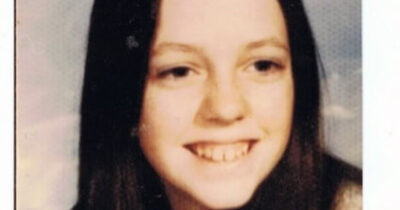In August 1975, 13-year-old Laura O’Malley mysteriously vanished from her home in Long Beach, New York. Her sudden disappearance left her family in shock and confusion. All she left behind was a cryptic handwritten note, the contents of which only deepened the mystery. The note offered no clear answers, only hints that perhaps she had planned to leave on her own.
For years, her family clung to hope, believing she might have run away to New York City. The bustling metropolis, just a short distance away, seemed like the most plausible place for a teenager to flee to in search of independence or escape. Flyers were posted, local authorities were contacted, and leads trickled in—but none led to Laura. Every phone call brought both hope and dread.
As the years passed, the O’Malley family held onto the belief that she might resurface. Every birthday and holiday was marked by absence, yet they refused to give up on the idea that she was out there, living under a new name, or perhaps simply afraid to return. The not knowing was the hardest part—worse than any answer they might receive.
In 1995, two decades after Laura disappeared, partial skeletal remains were found in a remote area of Santa Cruz County, California. At the time, the remains were unidentified, and while investigators speculated about who the person might have been, they had few leads. There was no immediate connection to Laura, and the remains were quietly archived, waiting for science to catch up.
It wasn’t until 2016 that significant progress was made. Forensic experts, using advanced DNA testing techniques that had not been available in the 1990s, confirmed that the remains belonged to a female. This small but crucial breakthrough reignited interest in the cold case. The remains were submitted for further analysis.
Eventually, DNA comparisons to samples provided by Laura’s surviving family members revealed the heartbreaking truth. After more than 40 years of uncertainty, the remains were officially identified as Laura O’Malley’s. The discovery brought a tragic form of closure to her loved ones, who had spent decades wondering what had happened to her.
Despite this breakthrough, many questions remain unanswered. It is still unknown how Laura ended up in California, thousands of miles from home. Investigators now believe she likely died between 1977 and 1984, placing her age at the time of death somewhere between 13 and 17. That detail suggests she didn’t die immediately after disappearing, raising even more painful possibilities.
Authorities are now trying to piece together Laura’s final years. Did she meet someone who led her across the country? Was she taken against her will? Or did she run away and fall into dangerous circumstances that led to her untimely death? Each theory carries its own weight, and law enforcement continues to search for answers.
The Santa Cruz County Sheriff’s Office has kept the case open, committed to uncovering the truth behind Laura’s disappearance and death. They hope that renewed public interest, along with evolving forensic tools, may eventually provide the missing pieces of her story. Cold cases like this often rely on someone coming forward—someone who remembers something, no matter how small.
Anyone with information is encouraged to contact the Santa Cruz County Sheriff’s Office. Even the smallest detail could finally bring justice for Laura and peace to a family that has suffered for decades.
